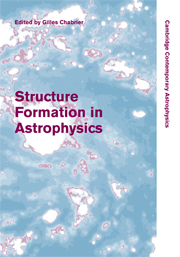Book contents
- Frontmatter
- Contents
- List of contributors
- Preface
- Part I Physical Processes and Numerical Methods Common to Structure Formations in Astrophysics
- Part II Structure and Star Formation in the Primordial Universe
- Part III Contemporary Star and Brown Dwarf Formation
- 9 Diffuse interstellar medium and the formation of molecular clouds
- 10 The formation of distributed and clustered stars in molecular clouds
- 11 The formation and evolution of prestellar cores
- 12 Models for the formation of massive stars
- Part IV Protoplanetary Disks and Planet Formation
- Part V Summary
10 - The formation of distributed and clustered stars in molecular clouds
Published online by Cambridge University Press: 11 August 2009
- Frontmatter
- Contents
- List of contributors
- Preface
- Part I Physical Processes and Numerical Methods Common to Structure Formations in Astrophysics
- Part II Structure and Star Formation in the Primordial Universe
- Part III Contemporary Star and Brown Dwarf Formation
- 9 Diffuse interstellar medium and the formation of molecular clouds
- 10 The formation of distributed and clustered stars in molecular clouds
- 11 The formation and evolution of prestellar cores
- 12 Models for the formation of massive stars
- Part IV Protoplanetary Disks and Planet Formation
- Part V Summary
Summary
Introduction
During the last two decades, the focus of star formation research has shifted from understanding the collapse of a single dense core into a star to studying the formation of hundreds to thousands of stars in molecular clouds. In this chapter, we overview recent observational and theoretical progress towards understanding star formation on the scale of molecular clouds and complexes, i.e. the macrophysics of star formation (McKee & Ostriker 2007). We begin with an overview of recent surveys of young stellar objects (YSOs) in molecular clouds and embedded clusters, and we outline an emerging picture of cluster formation. We then discuss the role of turbulence to both support clouds and create dense, gravitationally unstable structures, with an emphasis on the role of magnetic fields (in the case of distributed stars), and feedback (in the case of clusters) to slow turbulent decay and mediate the rate and density of star formation. The discussion is followed by an overview of how gravity and turbulence may produce observed scaling laws for the properties of molecular clouds, stars and star clusters and how the observed, star formation rate (SFR) may result from self-regulated star formation. We end with some concluding remarks, including a number of questions to be addressed by future observations and simulations.
Observations of clustered and distributed populations in molecular clouds
Our knowledge of the distribution and kinematics of young stars, protostars and dense cores in molecular clouds is being rapidly improved by wide-field observations at X-ray, optical, infrared and (sub)millimeter wavelengths (Allen et al. 2007; Feigelson et al. 2007).
- Type
- Chapter
- Information
- Structure Formation in Astrophysics , pp. 228 - 253Publisher: Cambridge University PressPrint publication year: 2009
- 3
- Cited by



